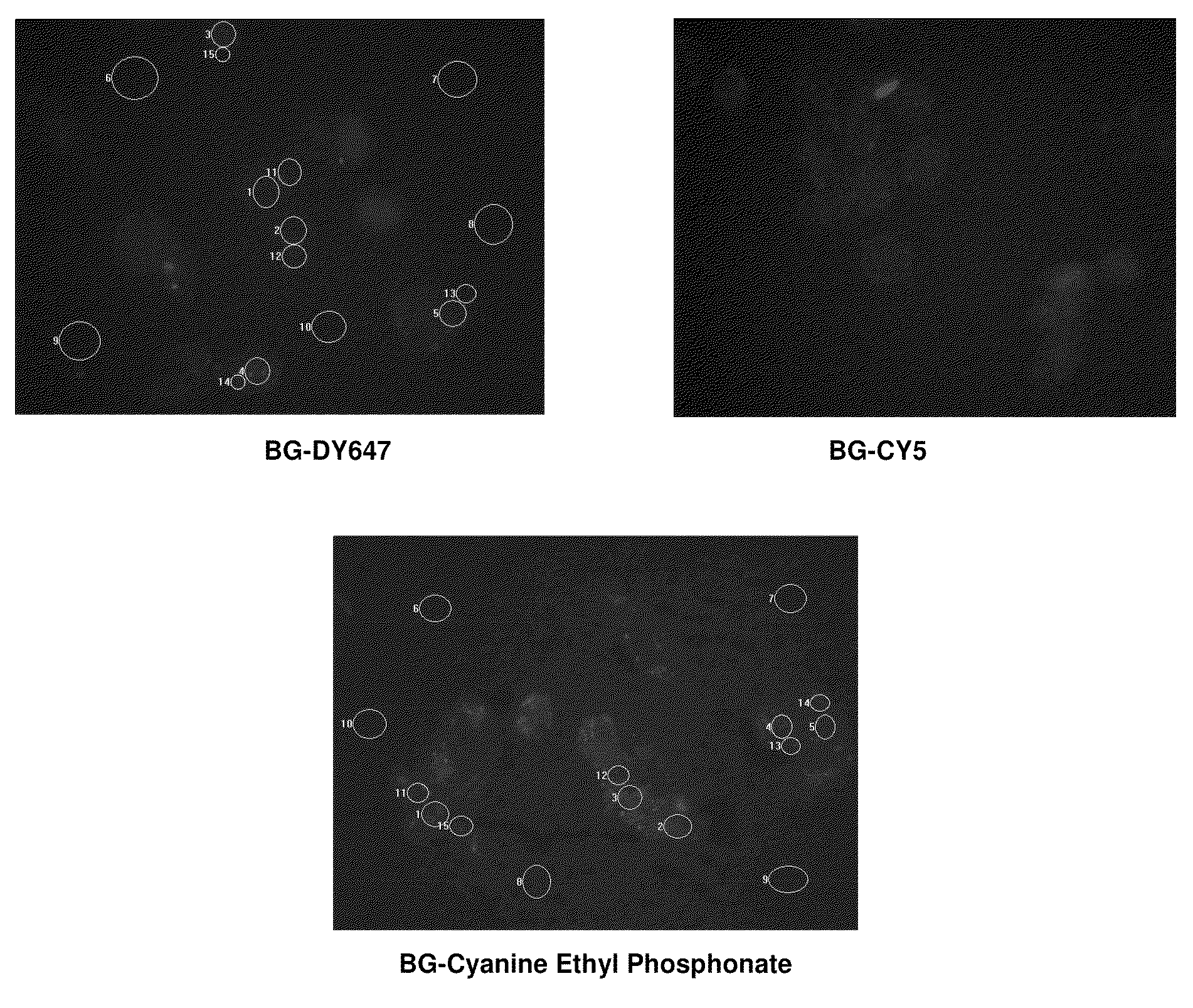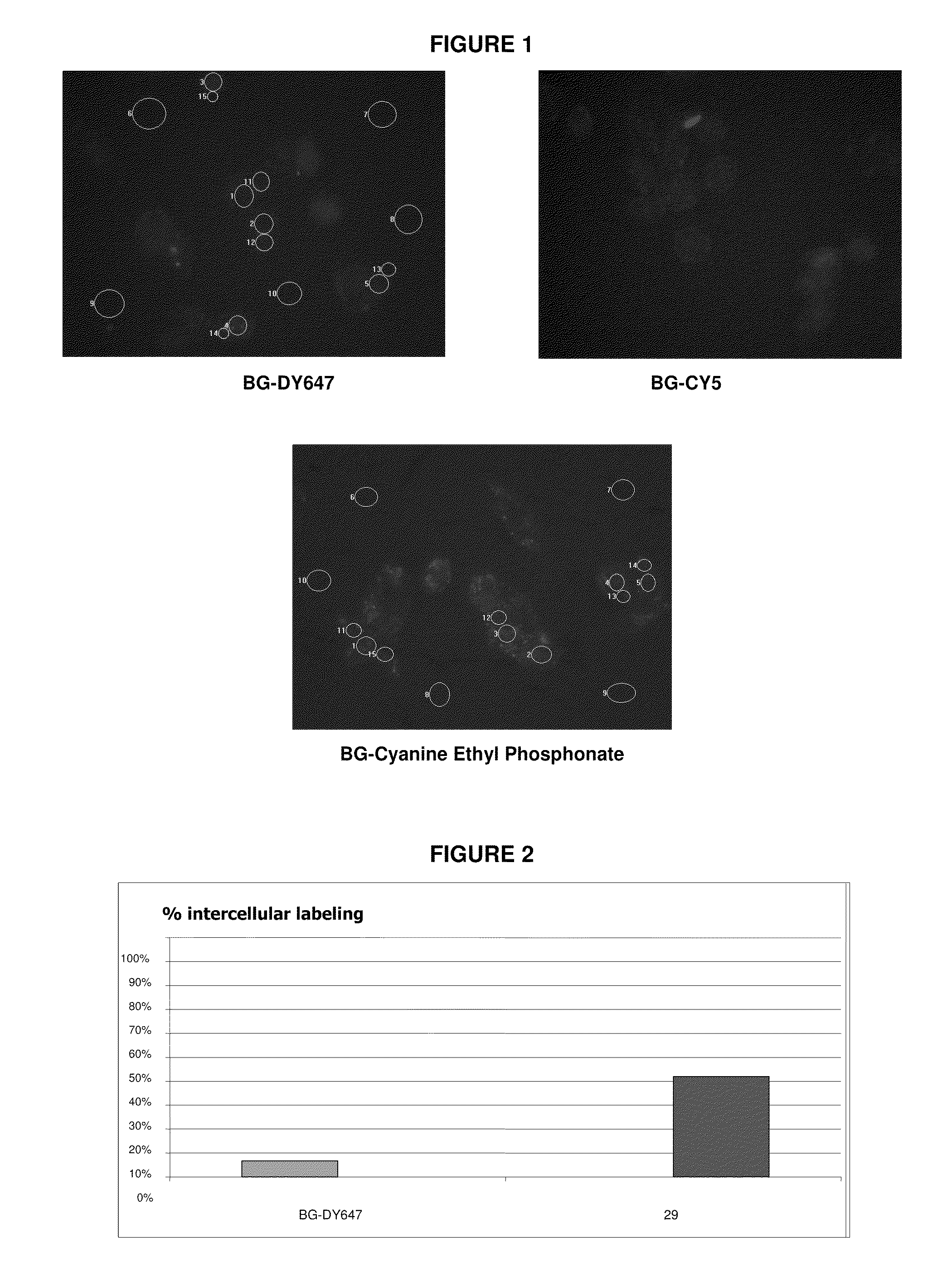Cyanine derivatives, fluorescent conjugates containing same and use thereof
a technology of fluorescent conjugates and derivatives, applied in the field of cyanine derivatives, can solve the problems of limited use of predictive tools for the property of passing through membranes, the relative influence of phosphonates, and the inability of phosphonates to be identified
- Summary
- Abstract
- Description
- Claims
- Application Information
AI Technical Summary
Problems solved by technology
Method used
Image
Examples
example 1
Synthesis of 1-[2-(diethoxyphosphoryl)-ethyl]-2,3,3-trimethyl-3H-indolium bromide
[0279]
[0280]1.59 g (10.0 mmol) of 2,3,3-trimethyl-3H-indole and 2.94 g (12.0 mmol) of diethyl bromoethylphosphonate are mixed and heated at 70° C. for 40 h with stirring. After cooling the reaction mixture, 10 ml of methanol are added and then, subsequently, 30 ml of water. The desired compound is isolated by column chromatography (silica RP-18) with a methanol / water gradient ranging from 1:1 to 5:1. MS (ESI+): 324.2. Yield: 775 mg (19%).
example 2
Synthesis of 3-(3-carboxypropyl)-1-[2-(diethoxyphosphoryl)ethyl]-2,3-dimethyl-3H-indolium chloride
[0281]
[0282]2.31 g (10.0 mmol) of 3-(3-carboxypropyl)-2,3-dimethyl-3H-indole and 2.94 g (12.0 mmol) of diethyl bromoethylphosphonate are dissolved in 10 ml of ethanol and stirred at 70° C. for 64 h. After returning to ambient temperature, the remaining liquid is extracted with two times 20 ml of water. The two combined aqueous phases are extracted twice with 20 ml of diethyl ether. The desired product, which has remained in the aqueous phase, is isolated by column chromatography (silica RP-18) with a methanol / water gradient ranging from 1:3 to 3:2 (each solvent comprising 2% by volume of 3M hydrochloric acid). The solution containing the desired product is neutralized with sodium bicarbonate and the mixture is concentrated and then deposited on a short column of silica RP-18. After having removed the inorganic salts by washing with water, the product, in the form of the sodium salt, is ...
example 3
Synthesis of 1-[2-(diethoxyphosphoryl)-ethyl]-3,3-dimethyl-2-((1E,3E)-4-(phenylamino)buta-1,3-dienyl)-3H-indolium chloride
[0283]
[0284]404 mg (1.0 mmol) of 1-[2-(diethoxyphosphoryl)ethyl]-2,3,3-trimethyl-3H-indolium bromide and 285 mg (1.1 mmol) of malonic aldehyde dianilide hydrochloride are dissolved in 10 ml of a mixture of acetic acid and acetic anhydride (v / v=3:2) and the mixture is stirred at 60° C. for 8 h. After returning to ambient temperature, 150 ml of water are added. The solution is deposited on a column of silica RP-18. After washing with 200 ml of water, the desired product is eluted with an acetonitrile / water gradient ranging from 1:2 to 3:2 (each solvent containing 2% by volume of 3M HCl). The solution containing the desired product is neutralized with sodium bicarbonate and the mixture is concentrated and then deposited on a short column of silica RP-18. After having removed the inorganic salts by washing with water, the product, in the form of the sodium salt, is e...
PUM
| Property | Measurement | Unit |
|---|---|---|
| molecular weight | aaaaa | aaaaa |
| fluorescence quantum yield | aaaaa | aaaaa |
| temperature | aaaaa | aaaaa |
Abstract
Description
Claims
Application Information
 Login to View More
Login to View More - R&D
- Intellectual Property
- Life Sciences
- Materials
- Tech Scout
- Unparalleled Data Quality
- Higher Quality Content
- 60% Fewer Hallucinations
Browse by: Latest US Patents, China's latest patents, Technical Efficacy Thesaurus, Application Domain, Technology Topic, Popular Technical Reports.
© 2025 PatSnap. All rights reserved.Legal|Privacy policy|Modern Slavery Act Transparency Statement|Sitemap|About US| Contact US: help@patsnap.com



